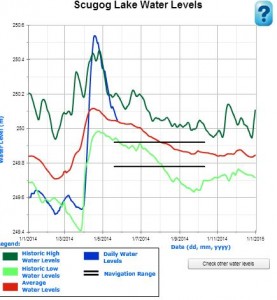Lake levels on Lake Scugog
In the fall of last year, our lake was taken down to well below average in order to have work carried out on the Scugog River to the north. What was left in the lake froze to record depths — well into the muck on the bottom. In April when the snow began to melt throughout the watershed, then the water rose rapidly to well above average levels. You can see from the chart taken from the Trent-Severn Waterway water level site as of today how the water rose very quickly to levels that flooded many low lying areas including homes and septic beds– especially at the north end of the lake. As the lake ice melted and the lake came open, wind exacerbated conditions on some shorelines causing a lot of erosion and loss of land into the lake.
Now the lake has dropped again to what are considered average levels, — about 250.2 m above sea level.
When the level of the lake was high, Ontario Waterways and Kawartha Conservation met with interested citizens around the lake many of whom were very keen to keep the water in the lake high to ena ble more recreational boating. It was argued that just because managed depths had been set more than 100 years ago, there was no reason why those managed depths could not change. However, that is not true for just the reasons mentioned above.
ble more recreational boating. It was argued that just because managed depths had been set more than 100 years ago, there was no reason why those managed depths could not change. However, that is not true for just the reasons mentioned above.
The yearly schedule of dam management for Lake Scugog generally is the following. The year starts with the dam wide open to ensure the watershed is not flooded during the spring melt. The land is generally saturated and new precipitation just runs off into the lake. Because Lake Scugog is so large, and its watershed is even larger than that, even if the dam is wide open it will take quite a while to drop the level of the lake to reasonable levels. As the season progresses, the freshette is over and the land dries out, logs are put into the dam; leaving only one out to enable fish spawning and transfer until mid or the end of June. Leaving a log out is a requirement set by the Ministry of Natural Resources.
Then for the remainder of the summer all the logs remain in the dam. If the water drops in the lake it is because of evaporation which can be very great because our lake has such a large surface to depth ratio and the water is warm. If the weather is hot, dry and windy, Lake Scugog can lose water depth very rapidly. No water from Scugog is used to keep the Trent-System high, feed power dams or even provide water for Lindsay or even Port Perry. Lindsay gets its water from above the Lindsay dam and Port Perry from wells to the south of the Lake.
Then in about mid October, the lake is once again dropped to winter levels to prevent flooding in the spring when manipulating the dam may be very hard to do.
Lake Scugog is dependent on water coming into the lake from the Nonquon River, the Cartwright Lands and creeks and streams around the lake as well as from groundwater seepage and stormwater runoff.
We encourage you key in ‘Trent-Severn water levels’ in google and then follow the prompts to Lake Scugog.
